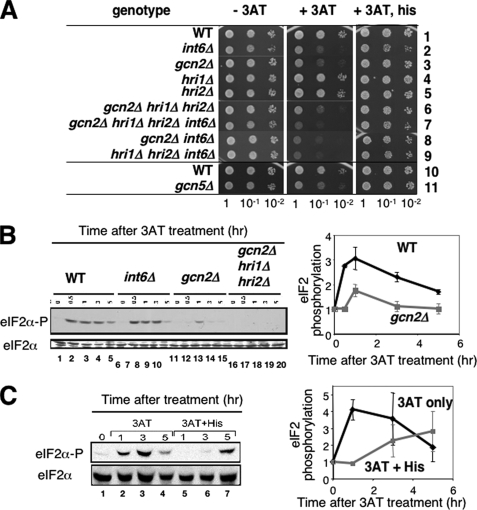FIGURE 1.
Int6, Gcn2, and Gcn5 are positive regulators of 3AT-induced starvation response in fission yeast. A, S. pombe strains WY764 (row 1), KAY252 (row 2), KAY406 (row 3), KAY309 (row 4), KAY311 (row 5), KAY296 (row 6), KAY329 (row 7), KAY415 (row 8), KAY609 (row 9), K340 (row 10), TY34 (row 11) containing the indicated mutations were grown overnight in rich medium (YES) and diluted to A600 = 0.15. 5 μl of each sample and its 10-fold serial dilutions were spotted onto EMM-C agar medium with supplements indicated to the top, and incubated for 4 days (left and right panels) or 7 days (middle panel) at 30 °C. The supplements were none (left panel), 10 mm 3AT (middle panel), and 10 mm 3AT and 10 mm histidine (right panel). B, eIF2 is phosphorylated in response to 3AT-induced stress. WY764 (WT), KAY252 (int6Δ), KAY406 (gcn2Δ), and KAY296 (gcn2Δ hri1Δ hri2Δ) cells were grown in EMM-C to an early exponential phase and then 30 mm 3AT was added. Cells were harvested for WCE preparation followed by immunoblotting with anti-phospho-eIF2α (top panel) or total eIF2α (bottom panel) antibodies, as described (16). The graph to the right shows relative levels of phospho-eIF2, normalized for total eIF2 levels in wild-type (black symbols) or gcn2Δ (gray symbols) cells. Bars indicate S.D. (n = 2). C, histidine reverses 3AT-induced eIF2 phosphorylation. Experiments in panel B were repeated with wild-type yeast (WY764) grown in the presence (lanes 5–7, gray symbols in the graph) or absence (lanes 2–4, black symbols in the graph) of histidine (1 mm) added to the medium together with 30 mm 3AT. The graph to the right shows relative levels of phospho-eIF2, normalized for total eIF2 levels with S.D. indicated by bars (n = 2).

